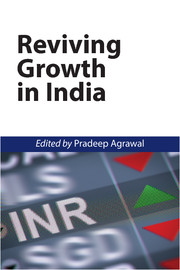Book contents
- Frontmatter
- Contents
- List of Tables and Figures
- Preface
- Section 1 The importance of growth
- Section 2 Reviving growth of industry and exports
- Section 3 The dampeners to growth: Controlling inflation
- Chapter 6 Macroeconomic Effects of Monetary Policy in India
- Chapter 7 Role of Monetary Policy in Sustaining High Growth in India: Lessons from the Recent Dynamics in Determination of Bank Credit
- Section 4 The supply constraints to growth
- Section 5 Emerging issues in growth: The labour and capital markets
- Contributors
- Index
Chapter 7 - Role of Monetary Policy in Sustaining High Growth in India: Lessons from the Recent Dynamics in Determination of Bank Credit
from Section 3 - The dampeners to growth: Controlling inflation
Published online by Cambridge University Press: 18 December 2015
- Frontmatter
- Contents
- List of Tables and Figures
- Preface
- Section 1 The importance of growth
- Section 2 Reviving growth of industry and exports
- Section 3 The dampeners to growth: Controlling inflation
- Chapter 6 Macroeconomic Effects of Monetary Policy in India
- Chapter 7 Role of Monetary Policy in Sustaining High Growth in India: Lessons from the Recent Dynamics in Determination of Bank Credit
- Section 4 The supply constraints to growth
- Section 5 Emerging issues in growth: The labour and capital markets
- Contributors
- Index
Summary
INTRODUCTION
India's economic performance during the post-reform period has been impressive in the backdrop of low and volatile growth during the first three decades since Independence. Not only the average growth during 1992–2013 at around 7.0 per cent is almost double of that achieved during 1951–80, but the growth performance has also been reasonably stable. Within the post-reform period, achieving a higher growth trajectory of around 9 per cent during 2003–08 and bouncing back from the fallout of global financial crisis during 2009–11 was phenomenal. However, economic slowdown during 2011–13 accompanied by adverse developments such as higher inflationary situation since 2009, fiscal deterioration at the central government level and surging current account deficit has been a matter of great concern. Particularly, economic growth in 2012–13 was at the decadal low of around 4.5 per cent, and the same for the current financial year is not expected to be any better.
While achieving high economic growth is not sufficient to solve all economic woes, it is essential for job creation, and thus, critically important for poverty reduction on an enduring basis. Moreover, sustained higher economic growth for a considerable period of time is generally found to improve various socio-economic indicators. In this perspective, an immediate issue is to what extent we should be concerned about current growth rates of about 5 per cent. A sense of comfort is expressed at certain quarters citing that even at current growth rates, India stands out as one of the world's fastest growing economy. In our view, there is no room for complacency. Given the level of unemployment and poverty existing in India, it has to grow at close to double digit level on a sustained basis so that a sizeable proportion of our population will overcome impoverished conditions every year. Thus, sooner we get back to the growth trajectory of 2003–08, better for us.
- Type
- Chapter
- Information
- Reviving Growth in India , pp. 170 - 194Publisher: Cambridge University PressPrint publication year: 2015

